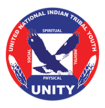
The 2025 UNITY Midyear Conference provided powerful platforms for Native youth to explore their deep connection to the Earth and the responsibility they hold as caretakers of sacred lands. The environmental workshops centered Indigenous knowledge, spiritual values, and collective activism as tools to protect the future of tribal communities. These sessions uplifted youth voices as defenders of land, water, and life itself—reminding them that environmental protection is a spiritual act of love for their people and planet.
In “Climate Change: Shaping a Safe Future for Tribal Communities,” Kaylee Evans (Haliwa-Saponi/Lumbee) invited youth to face climate challenges with courage and community. “Participants learned how rising temperatures, drought, and displacement uniquely affect Native communities. They left with ideas for climate advocacy rooted in our values of reciprocity and protection,” Evans said.
Cadence Hardy (Diné) led “Defending the Sacred Through Political Advocacy,” a youth-centered conversation on protecting Oak Flat. “We shared how prayer and protest go hand in hand. Youth felt empowered knowing their voices—and their ancestors—stand with them in defending sacred places,” Hardy shared.

Talon Watchman (Navajo) brought the conversation full circle in his “Mental Health and the Environment” session. “Youth talked about how being disconnected from land impacted their mental health. By naming sacred places that give them peace, they realized the land heals us too,” Watchman said.
Melody Billy’s workshop “Suicide and Substance Abuse Awareness” also connected wellness with environmental stress. “We talked about how destruction of land contributes to despair. Healing the land and ourselves must go hand in hand,” Billy reflected.
Several participants found healing through storytelling in these sessions. The youth shared that environmental trauma was personal: it involved their homes, waters, and future children. These conversations created a space to grieve, organize, and act.

In Kaylee Evans’ workshop, youth created group posters depicting safe futures. “Each poster showed medicine, elders, and water. They weren’t just imagining change—they were mapping it,” Evans said. These workshops demonstrated that environmental justice is a continuation of spiritual and cultural traditions. Youth recognized that they are not just allies to the land—they are the land.
By grounding climate activism in prayer, ceremony, and ancestral wisdom, UNITY empowered Native youth to lead movements that are culturally informed and spiritually guided. Through these sessions, youth reclaimed their role as protectors. They left the conference with clarity and commitment, knowing that defending the land is sacred work—and it begins with them.

